

 | Phyton-International Journal of Experimental Botany |  |
DOI: 10.32604/phyton.2022.019599
ARTICLE
The Effect of Bamboo Charcoal Application on Soil Nutrients and Heavy Metals in Rice
1State Key Laboratory of Subtropical Silviculture, Zhejiang A&F University, Hangzhou, 311300, China
2Jiaxing Vocational & Technical College, Jiaxing, 314036, China
3Agriculture and Forestry Technology Extension Center, Hangzhou, 311300, China
*Corresponding Author: Jiasen Wu. Email: jswu@zafu.edu.cn
Received: 30 September 2021; Accepted: 26 November 2021
Abstract: Soil heavy metal pollution is becoming more and more serious. Biomass charcoal application can play an important role in alleviating the toxicity of heavy metals in soils. Compared with other biochar, bamboo charcoal has more unique properties and may have a unique effect on heavy metal pollution. Zhejiang Province of Southeastern China is rich in bamboo resources. However, few studies related to bamboo charcoal application for heavy metal remediation in farmland were reported. In this study, four treatments with different amounts of bamboo charcoal application were set up through a field experiment, namely BC0 (no bamboo charcoal application), BC1 (2500 kg⋅ha−1), BC2 (5000 kg⋅ha−1), and BC3 (10000 kg⋅ha−1), and each treatment was replicated three times. The results showed that (1) The application of bamboo charcoal significantly increased the soil pH and organic matter content. Compared with BC0, the pH and organic content of BC3 increased by 7.4% and 17.4% (P < 0.05) respectively. (2) The HCl-extractable Cd content of paddy soil in the BC1 treatment was significantly lower than other treatments (P < 0.05), and decreased by 15.3%, compared with BC0. The soil HCl-extractable Zn and Cu content did not differ significantly between treatments (P > 0.05). (3) With the increase of bamboo charcoal application, the Cd content in rice gradually decreased, the BC3 treatment significantly decreased by 39.0% (P < 0.05), and the Zn and Cu contents in rice did not differ significantly between treatments (P > 0.05), compared with BC0. (4) Soil pH, organic matter and Cd in rice seeds were significantly negatively correlated (P < 0.01). The heavy metal content in rice does not change with the change of heavy metal content with HCl-extractable state in soil. It means bamboo charcoal does not reduce heavy metal content in rice by simply declining the heavy metal content with HCl-extractable state. The mechanism of action is relatively complicated, and further study is needed.
Keywords: Bamboo charcoal; rice; heavy metal pollution; paddy field; HCl-extractable heavy metal
Taking rice with excessive cadmium for the public has caused Itai–itai disease since the beginning of 20 century. Heavy metal pollution of soil, especially cadmium pollution of soil, has been attracting attention from all over the world. And the maximum limit standard of cadmium element in rice had been remanded [1]. The contamination of paddy rice by heavy metals has increased, with the potential to harm the entire food chain and subsequently on human health [2]. For example, Cd can affect the nervous system and cause kidney malfunction [3], heavy metal pollution of soil in China should not be ignored. The “National Survey Bulletin on Soil Pollution Status” released in 2014 showed that soil heavy metal points exceeded the standard rate of 16.1% in our country, and the treatment of soil heavy metal pollution has become a top priority [4].
As a cheap soil amendment, biomass charcoal has great potential in the treatment of heavy metal pollution. Biochar is a solid product of pyrolysis of biomass such as straw, dried branches and leaves, manure and sludge, which has loose porosity and a huge specific surface area [5]. It generally has a structure of highly aromatic and can absorb a mass of moisture and soil nutrients. It is widely used in agriculture [6]. The application of biomass charcoal can increase the nutrient content of nitrogen, phosphorus, and potassium in the soil, affect the conversion of soil nutrient elements, and alleviate or even improve soil compaction to a certain extent [7]. A moderate dose of biochar plays a role in the remission of heavy metal toxicity. In a previous study by Lu et al. [8], it was found that Rice straw biochar could effectively reduce the acid extractable metal fractions, and this effect becomes more pronounced with increasing biochar application rate. Rice straw biochar can also effectively immobilize heavy metals, thus reducing their mobility and bioavailability in contaminated soil. The application of biochar can not only reduce the toxicity of heavy metal but also provide nutrients for plants, achieving win–win effects of both soil improvement and production increase of crops.
Bamboo charcoal is a special kind of biochar with the material of bamboo wood. The carbon microcrystal of bamboo charcoal arranges as a “spiral layer structure”, and the strong cross-linking between multi-microcrystals generates a well-developed cellular structure of bamboo charcoal. The sizes of pores of bamboo charcoal are different and the surface structure of pores has imperfection characteristics. Under the effect of ash content and other atoms, the basic structure of bamboo charcoal will have defections and unsaturated prices. Oxygen atoms and other atoms will adsorb on these defections showing fortissimo physical absorption capacity [9,10]. In Zhejiang Province, the application of bamboo charcoal in agriculture is less, even though Zhejiang province abounds in bamboo.
We designed this experiment to investigate the prevention of heavy metal pollution in soil and the inhibition of heavy metal uptake in rice by bamboo charcoal. We hypothesized that bamboo charcoal can improve soil acidification, improve soil fertility, reduce the content of bioavailable heavy metals in soil, and reduce the content of heavy metals in rice.
The research area was located at an experimental field in Lin’an District, Hangzhou City, Zhejiang Province. The soil types of the test site were paddy soil type, infiltration paddy soil subtype and tillage sandy soil, and the tillage method was rice-rape rotation. Rice variety is Yongyou 5500. The plant samples were harvested by collecting rice plants according to the 3 point method. After washing, the plants were placed in an oven and killed at 105°C for 30 min, and then dried at 60°C to a constant weight, while the plant sample data were measured. Soil samples were collected from the topsoil (0–20 cm). The diagonal method was used for soil sampling at 3 points. The test biochar was commercially available bamboo charcoal, prepared at 400°C, crushed and passed through 0.154 mm sieve.
Biochar was used after smashing. Physicochemical properties are shown as follows in Table 1. The basic physicochemical properties of the test soil and the HCl-extractable state of heavy metals are shown in Table 2.


Field experiments were adopted in this experiment. The bamboo charcoal was used as base fertilizer on the surface of agricultural land. Four treatments with different application amounts were set, which are BC0 (0 kg⋅ha−1), BC1 (2500 kg⋅ha−1), BC2 (5000 kg⋅ha−1), BC3 (10000 kg⋅ha−1), respectively. Each treatment was carried out in triplicate.
The bamboo charcoal was utilized on 11 July, 2019. The harvest was on 15 October. A sampling of rice plants and arable soil was conducted at the same time. The entire period of duration was conducted common management according to the regulation of rice production under natural conditions.
2.3 Items and Methods of Measurement
Rice plants in each area were collected according to the three-point method when the rice was harvested in October 2019. Plant samples were firstly washed by running water again and again, then eluted by deionized water several times. They were put in the dryer at 105°C for 30 min for fixation, then dried to the constant weight under 60°C conditions. After that, rice was ere shelled and smashed. Soil samples of plough layer (0–20 cm) were collected according to the three-point method after the rice was harvested and a composite soil was made. After the removal of the wrack of flora and fauna and gravel, soil samples were used in the experiment of physical and chemical properties of soil after air drying, grinding and sieving with 2.00 mm.
Soil analysis methods were followed by Bao et al. [11]. The pH value was measured with a solid–liquid ratio 1:2.5 extraction acidity meter. Soil available potassium was extracted with 1 mol⋅L−1 neutral ammonium acetate solution, and then measured by flame spectrophotometer. Soil available phosphorus was measured by Brayetal method. The air-dried soil passing through the 2.00 mm sieve was leached with ammonium fluoride-hydrochloric acid solution, and the color was developed with a molybdenum-antimony anti-chromogenic agent, and then measured with a spectrophotometer. Soil organic matter was measured by using air-dried soil samples passing through a 0.149 mm sieve, using potassium dichromate volumetric method. Soil heavy metal with HCl-extractable state was extracted by dilute hydrochloric acid extraction and measured by atomic absorption spectrometer (ICE3000).
The heavy metal content of plants was measured by an inductively coupled plasma emission spectrometer (ICP-OES7000DV) after digestion with sulfuric acid and hydrogen peroxide.
All data of the experiment was pretreated through the inputting of Excel 2016 (Microsoft, USA), and one-way analysis of variance was conducted by Duncan method through SPSS10.0 software (Statistical Product and Service Solution, USA). Correlation analysis using Pearson’s method.
3.1 Growth and Biomass of Rice
The change of agronomic characteristics of rice after application of bamboo charcoal with different amounts was shown as Table 3. The plant height of rice was 126.5 to 146.0 cm, and the order according to height was BC2 > BC0 > BC1 > BC3, of which BC3 was significantly lower than BC2 (P < 0.05). The length of the ear of the rice was 26.7 to 28.1 cm, and the order was BC2 > BC1 > BC3 > BC0. There were no significant differences between different treatments (P > 0.05). Thousand kernel weight of rice was 23.7 to 26.1 g, the order was BC2 > BC1 > BC0 > BC3. There was no significant difference between different treatments (P > 0.05). Grain of rice and straw biomass were 632.7–880.5 kg/hm2 and 537.0–771.9 kg/hm2 respectively, and the order was BC3 > BC1 > BC0 > BC2. There was no significant difference between different treatments (P > 0.05). The biomass of the root system was 557.2 to 788.4 kg/hm2. There was no significant difference between different treatments (P > 0.05).

3.2 Physical and Chemical Properties of Soil
Soil pH value is an important soil physical and chemical property, and pH value is closely related to soil nutrients and soil available heavy metal content Table 4. With the increase of bamboo charcoal application amount, the pH value increased constantly. The pH values of soil with BC2 and BC3 treatments were significantly higher than that of BC0 treatment (P < 0.05).

Soil available N is one of the basic indexes of soil nutrients. With the increase of bamboo charcoal application amount, the content of soil available N rose to different extents. However, there was no significant difference between different treatments (P > 0.05). The available soil N content increased by 0.05% and 35.6% in BC1 and BC3 compared to BC0.
Soil available P is an important index of soil nutrients. With the increase of bamboo charcoal application amount, the available P of BC1 treatment was significantly higher than that of BC0 treatment after fertilization of a period of time and increased by 20.1%. There was no significant difference between BC2, BC3 and BC0 treatments (P > 0.05). However, the value decreased by 5.2% to 7.4% compared with the BC0 treatment. Available K of soil rose with the increase of bamboo charcoal application amount. The values in BC2, BC3 treatment increased by 9.8% to 15.0% compared with BC0 treatment. There was no significant difference compared with the BC0 treatment. The variation tendencies of available P and available K of soil were different.
With the increase of bamboo charcoal application amount, organic content showed an upward trend. Compared with BC0 treatment, the organic content of BC1 treatment increased by 0.3%. However, there was no significant difference between them (P > 0.05). Compared with BC0 treatment, the organic matter content significantly increased BC3 treatment, with an increase of 17.4% respectively. There was no significant difference between BC0, BC1 and BC2 (P > 0.05).
3.3 Heavy Metal with HCl-Extractable State of Soil
As shown in Fig. 1, with the increase of bamboo charcoal application amount, the change of soil HCl-extractable Cd content is more complicated. The order was BC0 > BC2 > BC3 > BC1. Compared with BC0 treatment, the HCl-extractable Cd of soil declined 0.6%–15.3%. BC1 treatment was significantly lower than other treatments (P < 0.05).
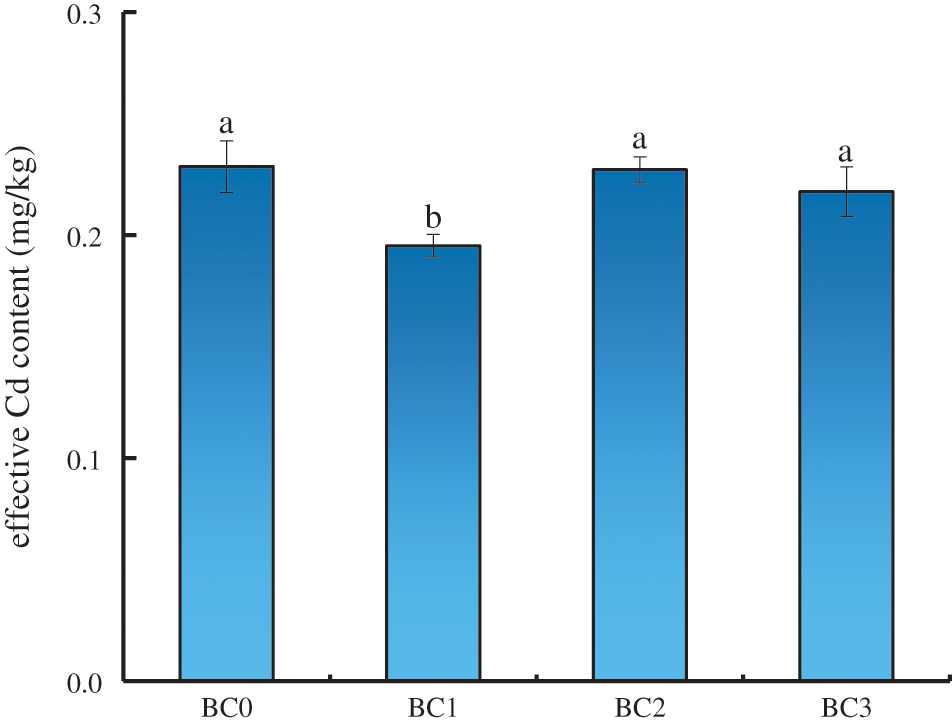
Figure 1: HCl-extractable Cd with different treatments
As shown in Fig. 2, with the increase of bamboo charcoal application amount, the HCl-extractable Cu of soil showed the tendency of increase first and then decreased. The order was BC1 > BC0 > BC2 > BC3. There was no significant difference between different treatments (P > 0.05). Compared with BC0 treatment, the HCl-extractable Cu increased by 2.0% of BC1 treatment, and HCl-extractable Cu decreased by 0.4%–1.8% of BC2 and BC3 treatments.
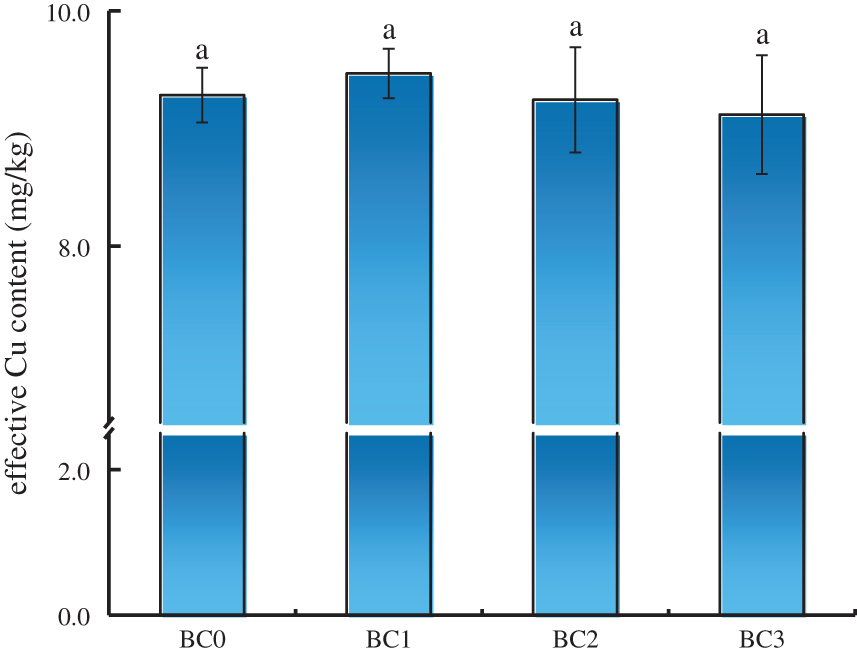
Figure 2: HCl-extractable Cu with different treatments
As shown in Fig. 3, with the increase of bamboo charcoal application amount, the HCl-extractable Zn of soil increased, compared with the BC0 treatment. There was no significant difference between different treatments (P > 0.05). Compared with BC0, Zn content increased by 0.1%–9.9% for each treatment.
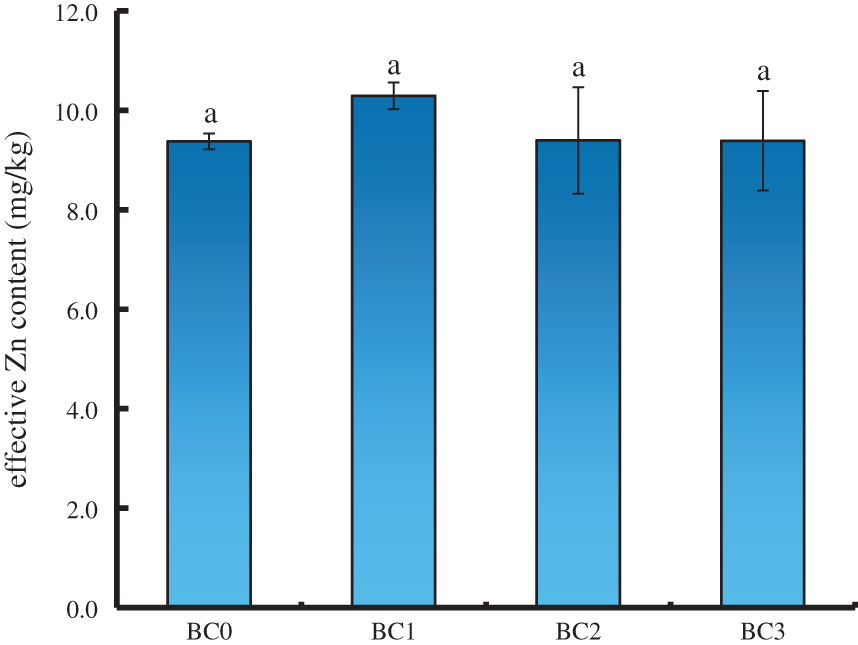
Figure 3: HCl-extractable Zn with different treatments
3.4 Heavy Metal Content in Rice Grain
As shown in Fig. 4, with the increase of bamboo charcoal application amount, the Cd content in rice grain decreased. The order was BC0 > BC1 > BC2 > BC3. BC3 treatment was significantly lower than other treatments (P < 0.05). Compared with BC0, the Cd content in grain rice decreased by 17.1%–39.0%.
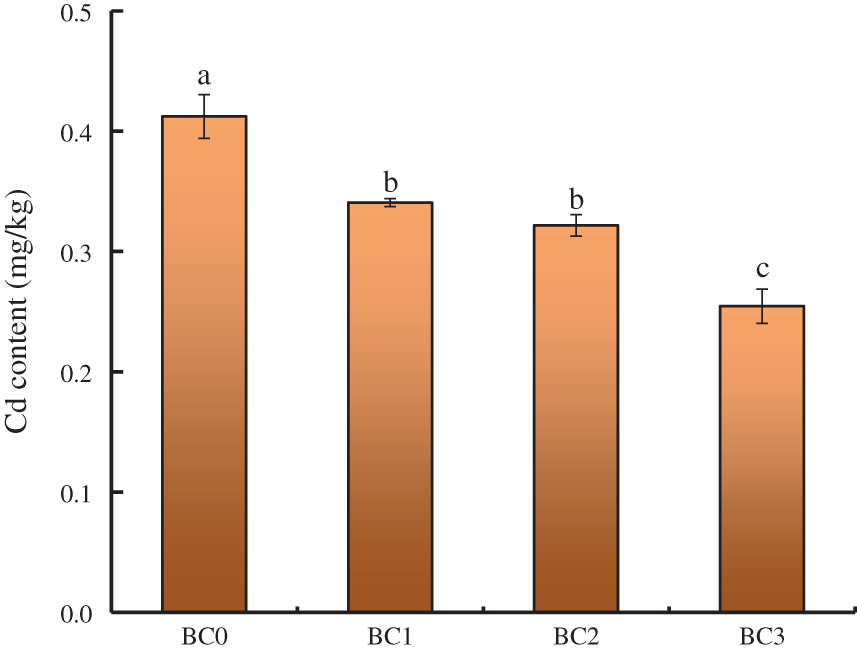
Figure 4: Cd content in rice grain under different treatments
As shown in Fig. 5, with the increase of bamboo charcoal application amount, the Cu content in rice grain increased. There was no significant difference between different treatments (P > 0.05). The order was BC1 > BC3 > BC2 > BC0. Compared with BC0, the Cu content in grain rice increased by 0.5%–3.2% for other treatments.
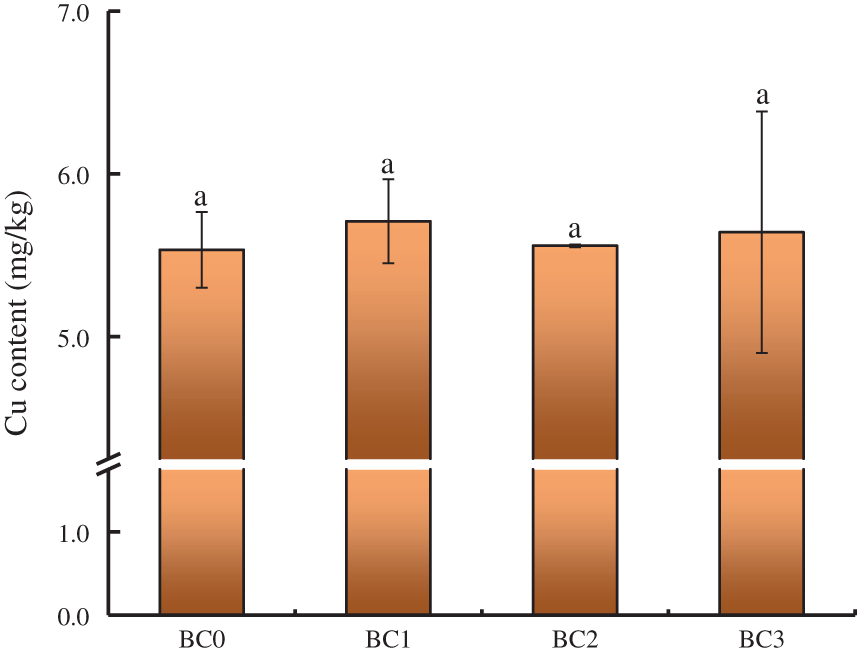
Figure 5: Cu content in rice grain under different treatments
As shown in Fig. 6, with the increase of bamboo charcoal application amount, the Zn content in rice grain showed the tendency of increase first and then decreased. There was no significant difference between different treatments (P > 0.05). Compared with BC0, the Zn content in grain rice increased by 11.0%–39.9% for other treatments.
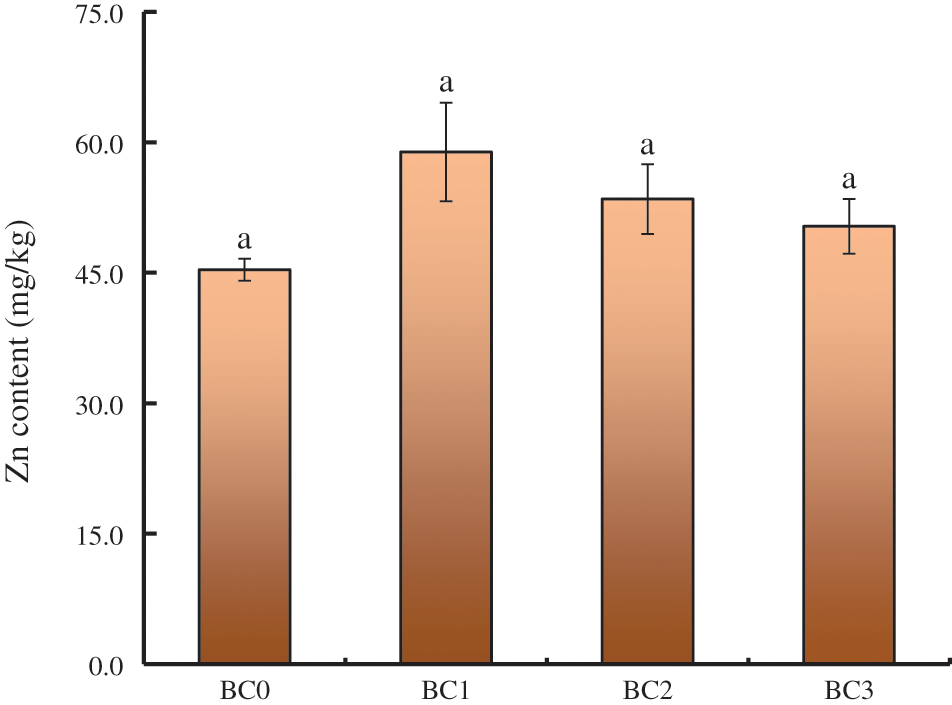
Figure 6: Zn content in rice grain under different treatments
As shown in Fig. 7, there was a significant negative correlation between HCl-extractable Cd and grain Cu with a correlation coefficient of −0.95; a significant positive correlation between HCl-extractable Zn and available P with a correlation coefficient of 0.96; and a significant positive correlation between soil pH and available K with a correlation coefficient of 0.97.
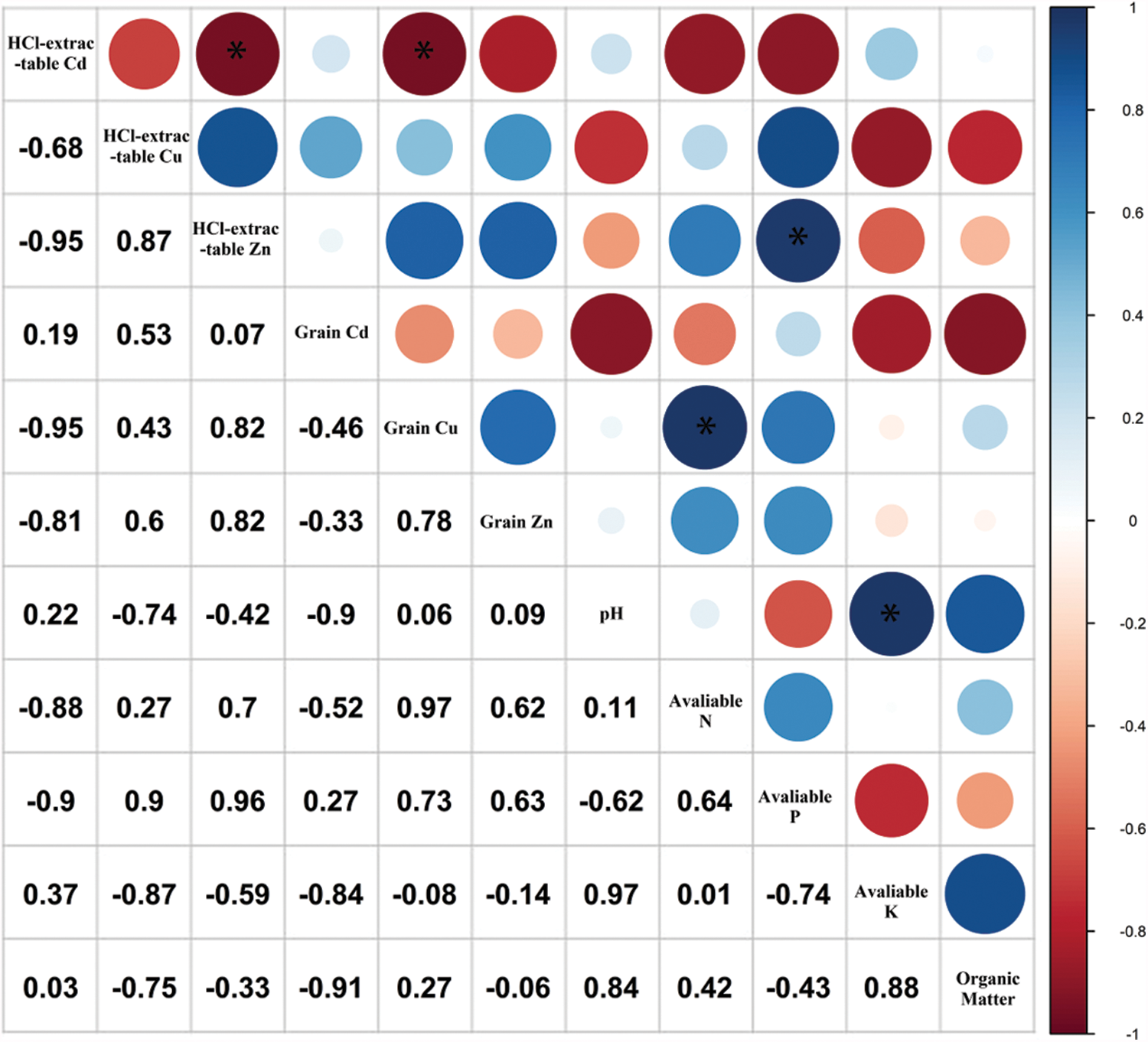
Figure 7: Correlation analysis. Note: * Means significant correlation at 0.05 level (bilateral)
4.1 The Effect of Bamboo Charcoal Application on Physical and Chemical Properties of Soil
The physical and chemical properties of soil can directly affect the migration, translation and species distribution of heavy metals. Therefore, the effect of bamboo charcoal on the physical and chemical properties of soil should be considered firstly [12]. Bamboo charcoal is a nature alkaline fertilizer in general. Research of Yuan et al. [13] showed that the application of biochar could neutralize acidity in acid soil, which can improve the soilpH and relieve soil acid damage. Chu et al. [14] also showed that biochar could increase soil pH, especially in acidic soils. Research of Pan et al. [15] showed that biochar could significantly improve the pH value of acid red soil, and the pH value of soil is gradually close to neutral with the increase of application time. pH value played an important role in the heavy metal content of the soil. According to the research of Ying et al. [16], the pH value of soil increased after the application of biochar, which could effectively relieve the damage of aluminum ions in acid soil. Regard as the heavy metal of soil, the increase of pH value of soil can generate sediment with slight solubility, which can reduce the migration of heavy metal elements. Compared with the common biochar of straw, bamboo charcoal not only can increase the pH value of soil, but also can absorb lots of heavy metal ions through absorption. Furthermore, it can reduce the bio-availability of heavy metal ions through chelation, which can reduce the content of heavy metal elements in plants [17–21]. The application of bamboo charcoal can make the significant increase of pH value of soil under the condition in this experiment, and pH value tends to be neutral, which is the same as the experimental results of Su et al. [22]
The research of Yang et al. [23] reported that there was no significant effect of biochar on the concentration of alkali-hydrolyzable nitrogen of soil, which is the same as the result in this experiment. Bamboo charcoal affects the alkali-hydrolyzable nitrogen of soil in two aspects. On the one hand, absorption of bamboo charcoal and high carbon–nitrogen ratio maybe can fix the available nitrogen of soil to reduce the content of alkali-hydrolyzable nitrogen. On the other hand, new and labile organic matter can increase the biomass and activity of microbial in soil and speed up the mineralization of nitrogen elements, which causes the increase of nitrogen content [23]. Sun et al. [24] reported that biofertilizer and biochar addition could provide available energy sources to soil microorganisms to stimulate denitrification and enhance N2O emission, which reduces the content of alkali-hydrolyzable nitrogen. Because of the short experimental environment and time, the bamboo charcoal used was fresh, and the effect of the bamboo charcoal on soil improvement had not been fully revealed, the effect of bamboo charcoal application on available K was not significant. According to studies, aged biochar had a higher cation exchange capacity (CEC), a higher concentration of negative surface charge, and a higher adsorption capacity of charged organic matter on the surface, and had a stronger nutrient retention capacity, while fresh biochar had a lower retention capacity of potassium ions than aged biochar [25]. In our experiment, as the amount of bamboo charcoal applied increased, the available P content showed a trend of first increasing and then decreasing. This may be bacause that bamboo charcoal itself has a high P content, which increases the level of available P, but the application of large amounts of bamboo charcoal to the soil also leads to a subsequent increase in alkaline oxides in the soil and an increase in soil pH, resulting in a decrease in available P in the soil [26]. Sun et al. [27] reported that the application of biochar to soils did not result in significant changes in available P in the soil in the short term.
Previous studies have shown that the addition of biochar in the soil can enhance the organic content of soil humus [28]. Because bamboo charcoal is external organic carbon. After imputed in soil, it can directly increase the organic carbon content of soil and weaken the mineralization process of organic matter, which isa benefit for the maintaining of long-term storage of organic matter of soil. Furthermore, bamboo charcoal can promote small organic molecules absorbed by it to aggregate and form organic matter through surface catalysis to increase the organic carbon content of the soil [29,30]. The application of bamboo charcoal can enhance the effective nutrient content of organic carbon and humus of soil, and change the structural composition. For example, the structure of humic acid will be more complicated which is a benefit for the long-term storage of organic carbon of soil [22,28]. Research of Chen et al. [31] reported that the nutrient content was significantly increased the in soil of 0–20 cm compared with only one fertilizer is utilized after the mix of bamboo charcoal and other organic fertilizers. It means bamboo charcoal has a better retaining fertilized function compared with other common bamboo charcoal of straw. Meanwhile, external nutrients will be absorbed on bamboo charcoal because bamboo charcoal has strong absorption action. While as the carrier of controlled release fertilizers, nutrients of bamboo charcoal have properties of reservation and slow release. Thus, it shows better retaining fertilized action [31,32].
4.2 The Effect of Bamboo Charcoal Application on Heavy Metal Content in Rice
The heavy metal content with HCl-extractable state in the soil can directly affect the heavy metal content in rice. Bamboo charcoal can reduce the heavy metal content with HCl-extractable state in the soil in various ways. Generally speaking, bamboo charcoal can fix heavy metal through complex reactions between ligating atoms on the surface and heavy metal atoms, reduce heavy metal elements through taking advantage of sediment between soluble carbonate and metal cation, and can affect the biological activity of heavy metal in the soil through affecting physical and chemical properties, such as pH value of soil and organic content, etc. [33].
According to the research of Hou et al. [34], the application of biochar could change the chemical forms of Cu, Zn and Cd. The residual form of Cu and Zn decreased, while the residual form of Cd increased. It means the bio-availability of Cu and Zn elements has increased, and that of Cd has decreased. Research of Su et al. [22] showed that bamboo charcoal could significantly enhance effectiveness of heavy metals in soil when the application amount of bamboo charcoal is small. HCl-extractable Cu and HCl-extractable Zn in soil show upward tendency, which is consistent with the conclusion of Su et al. [22]
Research of Zhou et al. [35] reported that the Cd content in rice grain was significantly related to the pH value of soil. When the pH value of soil increases and hydrogen ions in soil decrease, the competitive effect of Cd ions weakens, which can promote the absorption action of soil for Cd ions and decrease the HCl-extractable Cd in soil [34,35]. The application of bamboo charcoal significantly increases the pH value of soil in this experiment, and the highest value is 7.4%. The HCl-extractable Cd in soil decrease by 0.6%–15.3%, which is generally consistent with the result of Zhou et al. [35]
It should be noted that the effects of different biochar on heavy metals with HCl-extractable state in soil are huge because of the differences in the mechanism of action. The reduction of the effectiveness of bamboo charcoal on Cd is mainly due to the adsorption and complexation actions, while biochar of straw is to form sediment with heavy metal ions because of higher Si content [36]. Research of Bian et al. [37] showed that the application of biochar of rice straw could reduce Cd content in rice. Xiao et al. [38] research on three types of biochar, namely peanut shell charcoal, wheat straw charcoal and bamboo charcoal, showed that this three biochar could reduce the HCl-extractable Cd state in soil. The HCl-extractable Cd content decreased by 20.1%, 12.8% and 17.1% respectively in the treatments of peanut shell charcoal, charcoal of rice straw and bamboo charcoal. The effect of bamboo charcoal was worse. However, bamboo charcoal could effectively reduce the transfer of Cd from the underground part to the overground part. Therefore, it is observed that the effect of bamboo charcoal on the HCl-extractable Cd state in the soil is limited. But it can effectively reduce the effect of Cd content on rice, which is similar to the results got in this experiment.
The application of bamboo charcoal enhances the pH value of soil in this experiment. However, there is no significant correlation between heavy metal content with HCl-extractable state in soil with a pH value of soil. There was no significant correlation between the changes in Cu, Zn and Cd contents in plants and the increase in soil pH. Different heavy mental show different change tendencies, which means the change of heavy metal content is not consistent with the change of pH value under the treatment of bamboo charcoal. Heavy metal content in plants is perhaps related to the variety of bamboo charcoal and properties of heavy metal elements.
The application of bamboo charcoal can significantly increase the pH value and organic content of the soil. They increase with the increase of application of bamboo charcoal. When the application amount is 10000 kg⋅hm−2, they increase by 7.4% and 17.4%, respectively. However, the improvement effect of available K and available P are not significant.
With the increase of application amount of bamboo charcoal, the HCl-extractable Cd in soil decreases overall, of which the decrease is significant when the application amount is 2500 kg⋅hm−2. It decreases by 15.3%. However, the HCl-extractable Zn and HCl-extractable Cu in the soil slightly increase after the application of bamboo charcoal. They increase by 1.9% and 9.9% respectively when the application amount is 2500 kg⋅hm−2.
With the increase of application amount of bamboo charcoal, the Cd content in rice gradually decreases. And the maximum decrease is 39.0%. However, is it not significant for the change of Zn content and Cu content. The decrease of Cd content in rice is negatively correlated to the change of pH value.
The heavy metal content in rice does not change with the change of heavy metal content with HCl-extractable state in soil. It means bamboo charcoal does not reduce heavy metal content in rice by simply declining the heavy metal content with an HCl-extractable state. The mechanism of action is relatively complicated, and further study is needed.
Funding Statement: This work was financially supported by the Key Research and Development Plan of Zhejiang Province (No. 2019C02008-03).
Conflicts of Interest: The authors declare that they have no conflicts of interest to report regarding the present study.
1. Chen, N. C., Lin, D. S., Zheng, Y. J., Zhang, G. L. (2019). Health effects of soil nutrition and pollution. Science, 71(6), 11–18. [Google Scholar]
2. Zhao, K., Fu, W., Ye, Z., Zhang, C. (2015). Contamination and spatial variation of heavy metals in the soil–rice system in Nanxun county, Southeastern China. International Journal of Environmental Research and Public Health, 12, 1577–1594. DOI 10.3390/ijerph120201577. [Google Scholar] [CrossRef]
3. Bandara, J., Senevirathna, D., Dasanayake, D., Herath, V., Bandara, J. et al. (2008). Chronic renal failure among farm families in cascade irrigation systems in Sri Lanka associated with elevated dietary cadmium levels in rice and freshwater fish (Tilapia). Environmental Geochemisty and Health, 30, 465–478. DOI 10.1007/s10653-007-9129-6. [Google Scholar] [CrossRef]
4. Ministry of Environmental Protection of the People’s Republic of China, Ministry of land and resources of the People’s Republic of China (2014). National soil pollution survey bulletin. Environmental Education, 2014(6), 8–10. [Google Scholar]
5. Dong, L. L., He, J. Q., Lu, C. Y., Shi, L. L., Zhou, X. W. et al. (2021). Effect of increased soil organic carbon on rice growth by biochar and wormcast combined application. Soil and Fertilizer Sciences in China, (2), 87–95. DOI 10.11838/sfsc.1673-6257.20083. [Google Scholar] [CrossRef]
6. Liu, J. J., Yang, X., Lu, K. P., Zhang, X. K., Huang, H. G. et al. (2014). Effect of bamboo and rice straw biochar on the transformation and bioavailability of heavy metals in soil. Acta Scientiae Circumstantiae, 35(11), 3679–3687. DOI 10.13671/j.hjkxxb.2014.1044. [Google Scholar] [CrossRef]
7. Liu, M. L., Liu, Y., Chen, T. T., Zou, J., Shi, W. Q. et al. (2021). Rice straw biochar: Effect on nutrient absorption and yield of wheat in Jianghan plain. Chinese Agricultural Science Bulletin, 37(15), 7–13. DOI 10.11924/j.issn.1000-6850.casb2020-0396. [Google Scholar] [CrossRef]
8. Lu, K., Yang, X., Gielen, G., Bolan, N., OK, Y. et al. (2017). Effect of bamboo and rice straw biochars on the mobility and redistribution of heavy metals (Cd, Cu, Pb and Zn) in contaminated soil. Journal of Environmental Management, 186, 285–292. DOI 10.1016/j.jenvman.2016.05.068. [Google Scholar] [CrossRef]
9. Han, Q. Q., Zhou, S., Ding, R. S., Yuan, H., Guo, N. C. (2020). Application status and prospect of bamboo charcoal materials in water environment management. Journal of Agricultural Catastrophology, 10(3), 51–54. DOI 10.19383/j.cnki.nyzhyj.2020.03.023. [Google Scholar] [CrossRef]
10. Lahaye, J. (1998). The chemistry of carbon surfaces. Fuel, 77(6), 543–547. DOI 10.1016/S0016-2361(97)00099-9. [Google Scholar] [CrossRef]
11. Bao, S. D. (2000). Soil and agricultural chemistry analysis. Beijing, China Agriculture Press Co., Ltd. [Google Scholar]
12. Zhang, D., Wu, X. X., Ding, A. F., Li, T., Fang, X. (2019). Effects of hydrated lime and biochar on the bioavaiability of Cd and Pb and microbial activity in a contaminated soil. Environmental Chemistry, 38(11), 2526–2534. DOI 10.7524/j.issn.0254-6108.2019042101. [Google Scholar] [CrossRef]
13. Yuan, J. H., Xu, R. K., Zhang, H. (2011). The forms of alkalis in the biochar produced from crop residues at different temperatures. Bioresource Technology, 102(3), 3488–3497. DOI 10.1016/j.biortech.2010.11.018. [Google Scholar] [CrossRef]
14. Chu, L., Zhang, Y., Qian, L., Zhu, D., Sun, H. (2020). Influence of biochar on nitrogen use efficiency and root morphology of rice-seedling in two contrasting paddy soils. Phyton-International Journal of Experimental Botany, 89(4), 1035–1042. DOI 10.32604/phyton.2020.014506. [Google Scholar] [CrossRef]
15. Pan, T., Sun, X. X., Zhang, J. W., Wei, H., Xu, J. et al. (2021). Effect of biochar and organic matter on Cd accumulation in rice. Environmental Pollution & Control, 43(3), 332–337. DOI 10.15985/j.cnki.1001-3865.2021.03.012. [Google Scholar] [CrossRef]
16. Ying, J. G., Liu, Q. Y., Zhang, M. Y., Huang, Y., Peng, S. A. et al. (2016). Mitigative effect of Biochar on Aluminum toxicity of acid soil and the potential mechanism. Scientia Agricultura Sinica, 49(23), 4576–4583. DOI 10.3864/j.issn.0578-1752.2016.23.010. [Google Scholar] [CrossRef]
17. Fu, W., Dong, J., Ding, L., Yang, H., Ye, Z. et al. (2022). Spatial correlation of nutrients in a typical soil-hickory system of southeastern China and its implication for site-specific fertilizer application. Soil & Tillage Research, 217, 105265. DOI 10.1016/j.still.2021.105265. [Google Scholar] [CrossRef]
18. Cao, X., Ma, L., Liang, Y., Gao, B., Harris, W. (2011). Simultaneous immobilization of lead and atrazine in contaminated soils using dairy-manure biochar. Environmental Science & Technology, 45(10), 4884–4889. DOI 10.1021/es103752u. [Google Scholar] [CrossRef]
19. Guo, B. L., Chen, X. M., Jing, F., Yang, Z. J., Liu, W. et al. (2018). Effect of biochar addition on physicochemical properties and microbial biomass of the red paddy soil polluted by heavy metals. Journal of Soil and Water Conservation, 32(4), 279–284 + 290. DOI 10.13870/j.cnki.stbcxb.2018.04.044. [Google Scholar] [CrossRef]
20. Xia, P., Wang, X. J., Zhang, J., Wang, X., Song, J. K. et al. (2015). Immobilization of copper, lead and chromium in single and multiple contaminated soil with biochar. Chinese Journal of Soil Science, 47(1), 192–197. DOI 10.19336/j.cnki.trtb.2016.01.030. [Google Scholar] [CrossRef]
21. Ni, X., Huang, Q. Y., Ye, Z. Q. (2019). Effect of bamboo biochar application on cadmium morphological transformation in soil and cadmium accumulation in wheat. Jiangsu Journal of Agricultural Sciences, 35(4), 818–824. DOI 10.3969/j.issn.1000-4440.2019.04.010. [Google Scholar] [CrossRef]
22. Su, X. C., Hu, Y. Y., Zhao, W., Ye, Z. Q. (2014). Effect of addition of bamboo charcoal on soil chemical properties, heavy metal availability, and rice growth. Acta Agriculturae Zhejiangensis, 26(2), 439–443. DOI 10.3969/j.issn.1004-1524.2014.02.34. [Google Scholar] [CrossRef]
23. Yang, X. L., Liu, L., Liao, P., Wang, J., Liu, J. S. (2021). Persistent effects of biochar application on yield and soil properties in a double rice-cropping system. Acta Agriculturae Universitatis Jiangxiensis, 43(3), 497–503. DOI 10.13836/j.jjau.2021055. [Google Scholar] [CrossRef]
24. Sun, H., Zhang, Y., Yang, Y., Chen, Y., Jeyakumar, P. et al. (2021). Effect of biofertilizer and wheat straw biochar application on nitrous oxide emission and ammonia volatilization from paddy soil. Environmental Pollution, 275, 116640. DOI 10.1016/j.envpol.2021.116640. [Google Scholar] [CrossRef]
25. Liu, X. Y., Lu, H. H., Shi, Y., Wang, Y. F., Zhong, Z. K. et al. (2015). Effect of biochar on soil nutrients leaching and potential mechanisms: A review. Chinese Journal of Applied Ecology, 26(1), 304–310. DOI 10.13287/j.1001-9332.20141203.015. [Google Scholar] [CrossRef]
26. Zhang, W. F., Zhou, J. H., Yuan, Y. H., Huang, J., Li, C. L. et al. (2016). Effect of low-dose biochar on the enhancement of fertility and yield in upland red soils. Chinese Journal of Ecology, 5(3), 647–654. DOI 10.13292/j.1000-4890.201603.009. [Google Scholar] [CrossRef]
27. Sun, H., Jeyakumar, P., Xiao, H., Li., H., Li, X. et al. (2020). Biochar can increase Chinese cabbage (Brassica oleracea L.) yield, decrease nitrogen and phosphorus leaching losses in intensive vegetable soil. Phyton-International Journal of Experimental Botany, 91(1), 197–206. DOI 10.32604/phyton.2022.016492. [Google Scholar] [CrossRef]
28. Zhou, G. Y., Dou, S., Liu, S. J. (2011). The structural characteristics of biochar and its effect on soil available nutrients and humus composition. Journal of Agro-Environment Science, 30(10), 2075–2080. [Google Scholar]
29. Smebye, A., Alling, V., Vogt, R. D., Gadmar, T., Mulder, J. et al. (2016). Biochar amendment to soil changes dissolved organic matter content and composition. Chemosphere, 142, 100–105. DOI 10.1016/j.chemosphere.2015.04.087. [Google Scholar] [CrossRef]
30. Zhao, S. S., Xiao, G. Q., Chen, Y. C., Chen, Q. H., Deng, H. J. (2021). Continuous effect of different application rates of lime and biochar on the passivation of Cadmium pollution in paddy fields. Journal of Soil and Water Conservation, 35(1), 334–340. DOI 10.13870/j.cnki.stbcxb.2021.01.048. [Google Scholar] [CrossRef]
31. Chen, L. M., Li, X. Y., Yue, X. W., Li, K., Li, J. L. et al. (2019). Effect of mixed application of bamboo charcoal and organic fertilizer on yield and quality of red pitaya and soil amelioration. Ecology and Environmental Sciences, 28(11), 2231–2238. DOI 10.16258/j.cnki.1674-5906.2019.11.012. [Google Scholar] [CrossRef]
32. Wen, P., Wu, Z. S., He, Y. H. (2017). Microwave-assisted synthesis of a novel biochar-based slow-release nitrogen fertilizer with enhanced water-retention capacity. Sustainable Chemistry and Engineering, 5(8), 7374–7382. DOI 10.1021/acssuschemeng.7b01721. [Google Scholar] [CrossRef]
33. Shi, N. (2020). Research progress on biochar remediation of heavy metal pollution in soil. Agricultural Technology & Equipment, (7), 150–150+152. DOI 10.16258/j.cnki.1674-5906.2019.11.012. [Google Scholar] [CrossRef]
34. Hou, Y. F., AN, Z. L. (2011). Effect of the application biochar on the chemical fraction of heavy metals in polluted red soil. Journal of Inner Mongolia University (Natural Science Edition), 42(4), 460–466. [Google Scholar]
35. Zhou, K. N., Zhang, Y. Y., Ye, Z. Q., Dou, C. Y., Ye, Z. H. et al. (2021). Fertilizer application could improve the Zn and Cd accumulation of Sedum alfredii Hance. Phyton-International Journal of Experimental Botany, 90(4), 1217–1232. DOI 10.32604/phyton.2021.014951. [Google Scholar] [CrossRef]
36. Wang, Y. H., Yang, L., Kang, Y. C., Chen, X. H., Peng, J. et al. (2021). Characteristics and influencing factors of cadmium accumulation in different rice varieties under cadmium contaminated field conditions. Environmental Science, 42(11), 5545–5533. DOI 10.13227/j.hjkx.202104206. [Google Scholar] [CrossRef]
37. Bian, R. J., Chen, D., Liu, X. Y., Cui, L., Li, L. et al. (2013). Biochar soil amendment as a solution to prevent Cd-tainted rice from China: Results from a cross-site field experiment. Ecological Engineering, 58, 378–383. DOI 10.1016/j.ecoleng.2013.07.031. [Google Scholar] [CrossRef]
38. Xiao, R. F., Shen, P. C., Zhao, X. L. (2017). Effect of three types of biochar on bioavailablilty of cadmium in a red soil and yellow soil. Journal of Agro-Environment Science, 36(5), 915–920. DOI 10.11654/jaes.2016-1274. [Google Scholar] [CrossRef]
 | This work is licensed under a Creative Commons Attribution 4.0 International License, which permits unrestricted use, distribution, and reproduction in any medium, provided the original work is properly cited. |